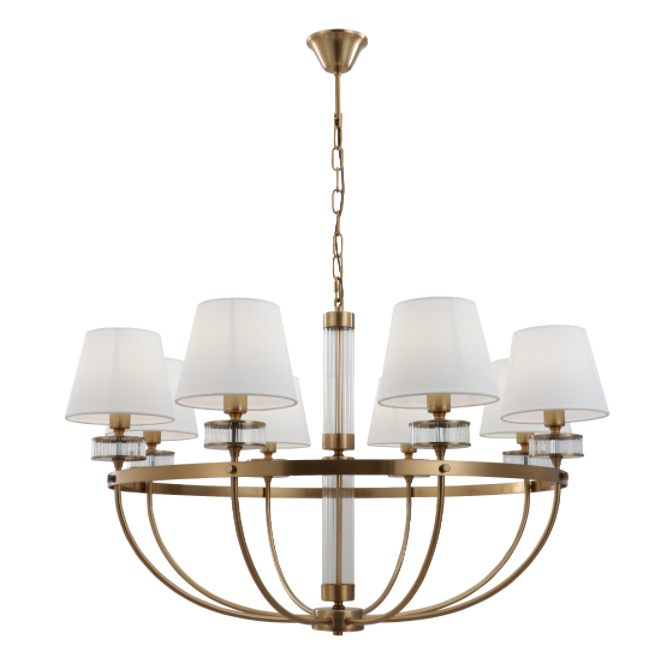What material is a chandelier usually made of?
2024-12-23
Chandeliers can be made from a wide variety of materials, depending on the design, style, and function. Here are the most common materials used in the construction of chandeliers:
1. Crystal
- Description: Often used for elegant, luxurious chandeliers, crystal is known for its ability to reflect and refract light, creating a sparkling effect.
- Common Types: Lead crystal, Swarovski crystals, or other high-quality glass crystals.
- Use: Traditional, ornate, or luxury chandeliers, especially in formal dining rooms, ballrooms, or grand spaces.
2. Glass
- Description: Glass is a versatile and widely used material, especially in modern or contemporary designs. It can be clear, frosted, or colored, and is often used for shades or decorative elements.
- Common Types: Murano glass, frosted glass, blown glass.
- Use: Modern, minimalistic, or artistic chandeliers, and those designed for diffused or soft lighting.

3. Metal
- Description: Metals are commonly used for the frame, arms, and other structural elements of chandeliers. Metal gives a chandelier strength, durability, and an elegant look, especially when polished or treated.
- Common Types: Brass, bronze, iron, steel, chrome, nickel, or gold-plated metals.
- Use: Traditional, modern, industrial, and contemporary chandelier designs.
4. Wrought Iron
- Description: Known for its durability and rustic charm, wrought iron is often used in more traditional, country, or rustic-style chandeliers. It is typically paired with glass or candle-style lights.
- Common Types: Blackened iron, oxidized or distressed finishes.
- Use: Rustic, farmhouse, or Mediterranean-style chandeliers.
5. Wood
- Description: Wood is used in chandeliers with a more natural or rustic style. It can add warmth and texture to a space.
- Common Types: Reclaimed wood, oak, pine, or other hardwoods.
- Use: Rustic, farmhouse, and coastal-themed chandeliers.
6. Acrylic
- Description: A lightweight and durable alternative to glass or crystal, acrylic can be molded into various shapes and is often used in modern or artistic chandeliers.
- Common Types: Clear acrylic or frosted acrylic.
- Use: Contemporary, modern, or minimalist chandeliers.
7. Fabric
- Description: Fabric is often used for shades on chandeliers, softening the light and adding texture or color.
- Common Types: Silk, linen, or cotton.
- Use: Traditional, transitional, or modern chandeliers.
8. Stone
- Description: Some high-end chandeliers use semi-precious stones or marble accents for a more luxurious and unique look.
- Common Types: Marble, alabaster, or gemstones like onyx, agate, or amethyst.
- Use: Luxury, statement, or bespoke chandeliers.
9. Ceramic or Porcelain
- Description: Ceramic or porcelain chandeliers often have decorative, artistic designs and can be hand-painted or glazed.
- Common Types: Porcelain, earthenware, or ceramic elements.
- Use: Vintage, antique, or eclectic chandeliers.
10. Aluminum
- Description: Aluminum is lightweight and corrosion-resistant, often used for sleek, modern chandeliers.
- Common Types: Polished, brushed, or matte aluminum finishes.
- Use: Modern, minimalist, or industrial-style chandeliers.
11. Bamboo or Rattan
- Description: These natural materials are used in chandeliers that aim for an organic, tropical, or bohemian aesthetic.
- Common Types: Woven bamboo or rattan.
- Use: Coastal, boho-chic, or tropical-themed chandeliers.
12. Paper
- Description: Paper or parchment can be used in lightweight chandeliers, often as a decorative shade.
- Common Types: Washed paper, rice paper, or craft paper.
- Use: Modern, artistic, or minimalist chandeliers, especially in eco-friendly designs.
---
These materials are often combined in various ways to achieve unique designs. For example, a chandelier might feature a crystal frame with glass elements or a metal frame with wood accents. The choice of materials determines the chandelier’s aesthetic, durability, and suitability for different environments.


